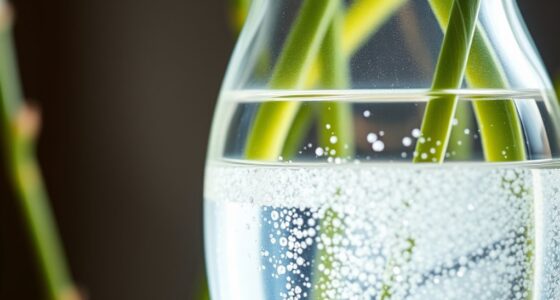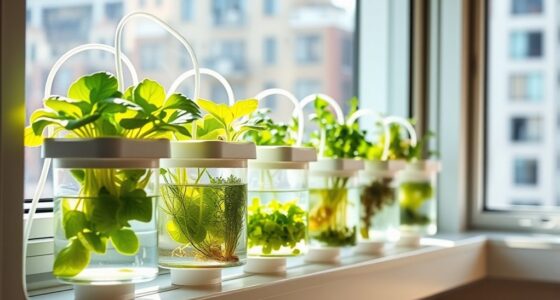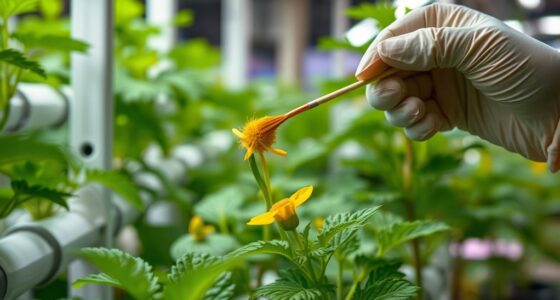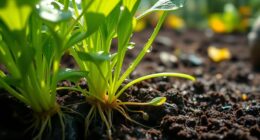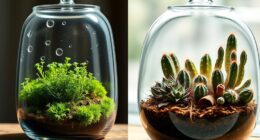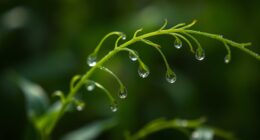Cloning in hydroponics using aeroponic cloners and rooting hormones allows you to quickly produce healthy, uniform plants with high success rates. Aeroponic systems suspend cuttings in a mist environment, delivering nutrients and oxygen directly to developing roots, which accelerates growth. Applying rooting hormones with auxins like IBA further boosts root development and success. If you want to master this technique and optimize your propagation process, there’s more to uncover just ahead.
Key Takeaways
- Aeroponic cloners suspend cuttings in a mist environment, providing optimal oxygen and nutrient delivery for rapid root development.
- Use rooting hormones like IBA or NAA to enhance root growth and increase cloning success rates.
- Maintaining high humidity and proper temperature levels in aeroponic systems promotes healthy, vigorous root formation.
- Proper sanitation and clean tools prevent infections and improve clone survival in hydroponic environments.
- Combining aeroponic cloning with hormonal treatment accelerates propagation, resulting in faster, consistent plant production.
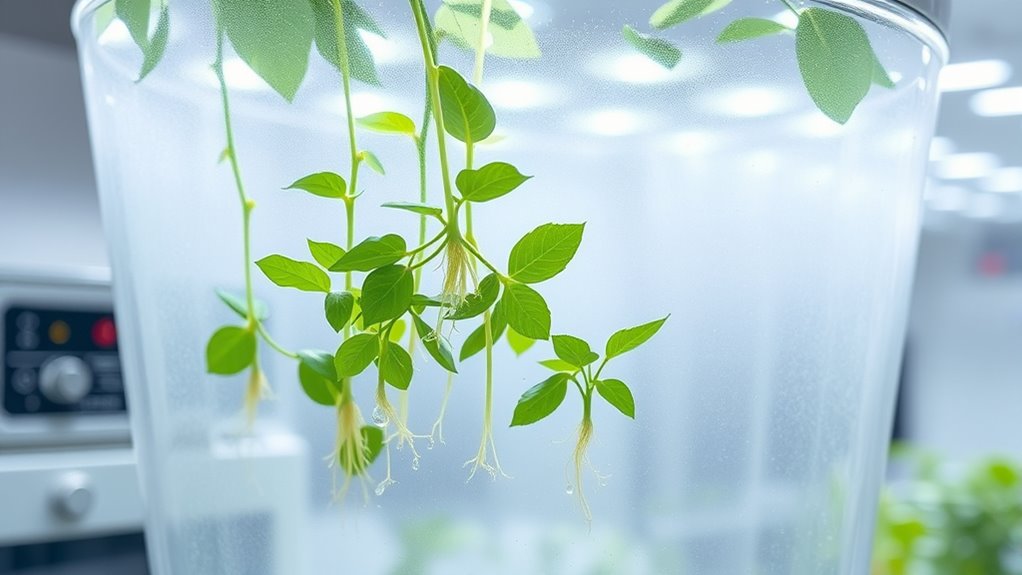
Cloning in hydroponics offers a fast and efficient way to propagate healthy, uniform plants without the variability of seed-grown specimens. When you clone plants, you’re fundamentally creating exact genetic copies, ensuring that the traits you desire are preserved. To achieve successful cloning, you need to understand and utilize effective cloning techniques. These methods involve carefully selecting parent plants, making precise cuttings, and providing ideal conditions for root development. One essential factor in this process is the use of rooting hormones, which stimulate root growth and increase the success rate of your clones. These hormones, typically containing auxins like indole-3-butyric acid (IBA) or naphthaleneacetic acid (NAA), are applied directly to the cut site or included in a rooting medium. They help your cuttings develop strong roots faster, reducing the risk of rot or failure.
Using cloning techniques in hydroponics often involves preparing your cuttings by trimming leaves and stems to encourage energy focus on root formation. Once prepared, you dip the cuttings into rooting hormones or apply them to your growing medium, such as rockwool or foam. The advantage of hydroponic systems, especially aeroponic cloners, is that they provide a controlled environment with high oxygen levels and consistent moisture, which are ideal for root development. Aeroponic cloning systems suspend cuttings in a mist environment, delivering nutrient-rich water and oxygen directly to the stem, creating perfect conditions for rapid root growth. This method drastically cuts down the time needed for clones to establish and become transplant-ready.
When you combine effective cloning techniques with rooting hormones, you markedly improve your success rate. The hormones encourage quicker root formation, while the aeroponic system maintains ideal humidity, temperature, and oxygenation. You’ll find that your clones develop robust roots within a week or two, ready for transfer into your hydroponic setup. It’s important to monitor your clones closely, adjusting environmental parameters to prevent stress or disease. Proper sanitation and handling also play essential roles; always use clean tools and gloves to avoid contamination. Additionally, understanding the importance of lifestyle factors such as maintaining consistent environmental conditions can further optimize your cloning success.
Frequently Asked Questions
What Are the Best Hormone Concentrations for Different Plant Species?
When considering hormone types and concentration optimization, you should know that different plant species respond uniquely. Usually, auxins like IBA or NAA are effective for rooting, with concentrations typically ranging from 0.1% to 1%. For species requiring faster growth, cytokinins might be used at low concentrations. Always start with a lower concentration and adjust based on your plant’s response to avoid overstimulation or damage.
How Do Temperature and Humidity Affect Cloning Success Rates?
You should focus on humidity control and temperature regulation to boost your cloning success rates. Maintaining high humidity prevents your cuttings from drying out, while keeping the temperature steady around 20-25°C encourages root growth. Fluctuations can stress your plants, reducing success. By carefully managing these environmental factors, you create ideal conditions that help your clones develop strong roots and thrive.
Can Cloning Be Done Without Hormonal Supplements?
You can clone plants without hormonal supplements, but it may affect genetic stability and success rates. While natural methods work, hormones often boost root development, ensuring healthier clones. Consider cloning ethics, such as maintaining genetic diversity and avoiding over-reliance on chemicals. If you prefer a natural approach, optimize environmental conditions like humidity and temperature, but be aware that success might be lower compared to hormone-enhanced methods.
What Are Common Signs of Unsuccessful Cloning?
You’ll notice unsuccessful cloning when your cuttings don’t develop roots or show signs of health, like yellowing or wilting leaves. Genetic variation can influence clone success, making some cuttings more resilient than others. Remember, cloning ethics emphasize minimizing harm and ensuring healthy propagation. If you see persistent failure, reassess your techniques and consider the impact on plant diversity, ensuring responsible practices while aiming for successful, healthy clones.
How Long Does It Typically Take for Clones to Root?
Rooting time varies, but generally, you can expect clones to root within 7 to 14 days. During this period, hormone optimization plays a vital role, helping roots develop faster and stronger. You should monitor environmental conditions closely, keep humidity high, and guarantee proper temperature. Consistent care and hormone use accelerate rooting, making the process more predictable. Patience and proper techniques will guarantee your clones establish quickly and successfully.
Conclusion
So, now that you’re armed with the secrets of aeroponic cloning and hormone magic, why settle for slow, uncertain plant growth? Immerse yourself in the world of high-tech propagation and watch your garden transform into a botanical powerhouse. Who knew that a little cloning could turn you into the ultimate green thumb? Just remember: with great power (and hormones) comes great responsibility—and maybe a few extra plants you didn’t plan for. Happy cloning!



